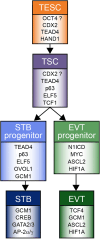Human placenta and trophoblast development: key molecular mechanisms and model systems
- PMID: 31049600
- PMCID: PMC6697717
- DOI: 10.1007/s00018-019-03104-6
Human placenta and trophoblast development: key molecular mechanisms and model systems
Abstract
Abnormal placentation is considered as an underlying cause of various pregnancy complications such as miscarriage, preeclampsia and intrauterine growth restriction, the latter increasing the risk for the development of severe disorders in later life such as cardiovascular disease and type 2 diabetes. Despite their importance, the molecular mechanisms governing human placental formation and trophoblast cell lineage specification and differentiation have been poorly unravelled, mostly due to the lack of appropriate cellular model systems. However, over the past few years major progress has been made by establishing self-renewing human trophoblast stem cells and 3-dimensional organoids from human blastocysts and early placental tissues opening the path for detailed molecular investigations. Herein, we summarize the present knowledge about human placental development, its stem cells, progenitors and differentiated cell types in the trophoblast epithelium and the villous core. Anatomy of the early placenta, current model systems, and critical key regulatory factors and signalling cascades governing placentation will be elucidated. In this context, we will discuss the role of the developmental pathways Wingless and Notch, controlling trophoblast stemness/differentiation and formation of invasive trophoblast progenitors, respectively.
Keywords: Chorionic villus; Mesenchymal cell; Placenta development; Trophoblast differentiation; Trophoblast stem cell.
Figures




Comment in
-
Breach of Security? Placental Uptake of Micro- and Nanoplastic Particles.Environ Health Perspect. 2022 Nov;130(11):114001. doi: 10.1289/EHP12180. Epub 2022 Nov 1. Environ Health Perspect. 2022. PMID: 36318466 Free PMC article.
References
Publication types
MeSH terms
Grants and funding
LinkOut - more resources
Full Text Sources
Other Literature Sources
Miscellaneous

